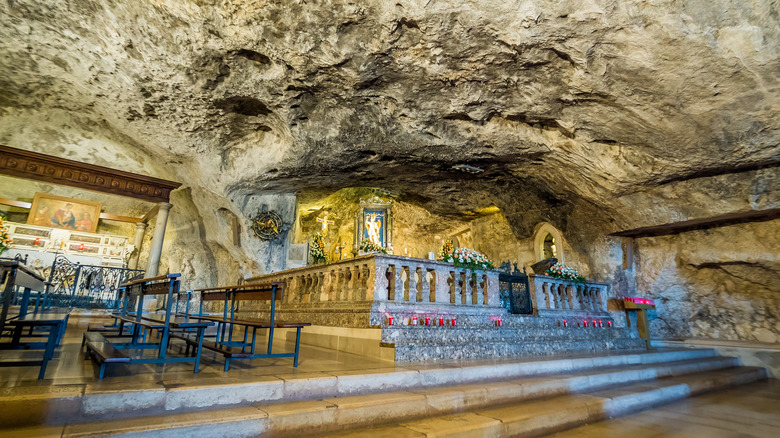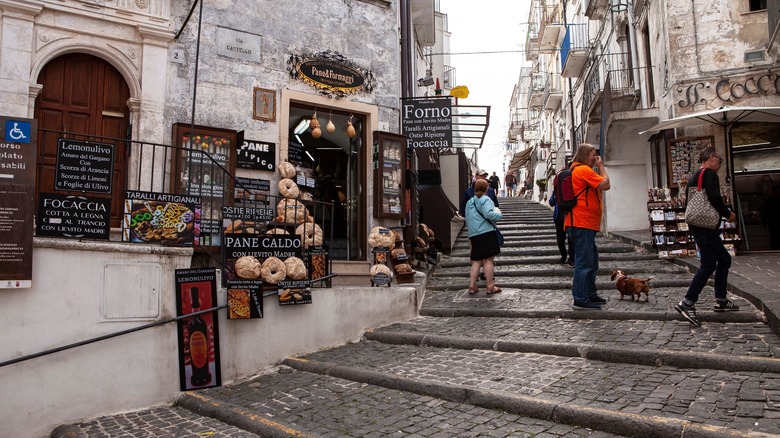Puglia's Hidden Gem Is A Medieval Town With Charming Squares And Streets Tucked In The Italian Mountains
From its perch in Puglia's Gargano region, the medieval town of Monte Sant'Angelo is announced by rows of whitewashed houses tracing the slope of the hillside it's nestled upon. One of the little-known towns exuding old-world charm along Italy's coast, Monte Sant'Angelo's main attraction is the Sanctuary of San Michele, a UNESCO World Heritage Site since 2011. It dates back to the 5th century, when the holy apparitions of Saint Michael the Archangel were said to have occurred in the town's cave.
While the Sanctuary attracts its fair share of devotees and tourists, there is much more to Monte Sant'Angelo. The historic 9th-century castle, a medieval town center with its cobblestone streets and stairways, stunning views of the Gulf of Manfredonia, and the overall atmosphere of this centuries-old town can seemingly transport you back in time, provided that you're visiting during the quieter and cooler months of April to June, away from the throngs of summer tourists.
Italian airline Neos Air announced its first direct flight route from New York to Puglia via the Bari Karol Wojtyla Airport, making travel around the Gargano region easier than ever for Americans. From Bari, a port city famous for fresh homemade pasta, it's a two-hour drive to Monte Sant'Angelo. From Foggia, which can be reached by airport or the high-speed Frecciargento train, Monte Sant'Angelo is under an hour by car or an hour and a half away by the SITA bus line. The drive to Monte Sant'Angelo is not for the fainthearted, though: Be prepared for a steep ascent and hairpin turns, though the views from your car window will be undeniably magnificent.
Monte Sant'Angelo's religious sites and a historic old town
Named by National Geographic as one in 10 of the world's most sacred caves, The Sanctuary of San Michele has been a pilgrimage site for many of its devotees. The octagonal Bell Tower, dating back to 1274, soars 27 meters high and flanks the right side of the sanctuary complex. The upper atrium leads visitors to the imposing arched-doorway entrance. Inside, a vestibule announces an 86-step staircase that takes you to the underground grotto with a series of sacred caverns. The visit promises a breathtaking and solemn experience, Catholic or otherwise, especially with the knowledge that past kings, popes, and crusaders had graced this sacred site centuries ago.
Crowning the town's summit is the Castle of Monte Sant'Angelo, where Norman, Swabian, and Aragonese influences are woven into its architecture. Over the centuries, the monument's architecture and purpose evolved from stronghold to prison to royal residence, until coming under the ownership of the city in 1907. A modest $2.30 (€2) entrance fee allows you to visit the castle's well-preserved interiors, explore its passageways, and soak in bird's eye views of the Gargano landscape from its tower and ramparts.
The city's activities revolve around Rione Junno. The city's old town center is distinctive for its rows of whitewashed terraced buildings neatly lined along arteries of meandering pathways and stairways. Pilgrims initially built these small shelters as refuges, and they were later occupied as homes, with large families often sharing the small space with animals.
Artisanal and gastronomic delights of Monte Sant'Angelo
The small streets reveal restaurants and bakeries that entice the senses. Don't leave without sampling the local bread: round, heavy sourdough loaves, whose soft interiors are enveloped in crusty tops. They are often displayed on bakery storefronts and are beautifully paired with local caciocavallo podolico cheese. As a sweet treat, try the ostie ripiene, a wafer of caramelized almonds. Wooden figures of St. Michael the Archangel and other traditional crafts are carved by the artisans of Monte Sant'Angelo, the most skillful carvers being Mimi Palenea and Matteo La Torre. You can drop by the numerous artisan workshops installed in the old town.
Monte Sant'Angelo is also a strategic base for visiting the surrounding sites of the Gargano region. Nature lovers can enjoy lakes and wildlife, as well as hikes and bike rides through the 15 trails around the Umbra Forest, a UNESCO World Heritage site that's a 40-minute drive away. Take a half day to visit San Giovanni Rotondo, a small town and pilgrimage site famous for the contemporary church dedicated to St. Pio of Pietrelcina. And in under two hours you can arrive at Foggia, an authentic Italian city of outdoor beauty, local cuisine, and agricultural importance in the region.


